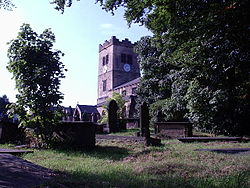Drighlington
| Drighlington | |
| Yorkshire West Riding | |
|---|---|
 St Paul's Church | |
| Location | |
| Grid reference: | SE224289 |
| Location: | 53°45’24"N, 1°39’42"W |
| Data | |
| Population: | 5,528 (2011) |
| Post town: | Bradford |
| Postcode: | BD11 |
| Dialling code: | 0113 |
| Local Government | |
| Council: | Leeds |
| Parliamentary constituency: |
Morley and Outwood |
Drighlington is a village in the West Riding of Yorkshire, five miles south-west of Leeds and four miles south-east of Bradford. The population of the civil parish as of the 2011 census was 5,528.
The village is at the junction of the A58 Leeds-Halifax road and the B6135 Tong to Gildersome Street road. This junction is known as the Drighlington Crossroads. The A650 now bypasses Drighlington to the west of the village following part of the structure of what was the Bradford to Wakefield and London Great Northern Railway line.
Name
The earliest mention of Drighlington is to be found in the Domesday Book of 1086, in the forms Dreslintone and Dreslingtone,[1] followed by an attestation in 1202 in the form Drichtlington and subsequent spellings along these lines.
The name comes from Old English. The first element is a personal name, whose original form is no longer clear but was probably Dryhtel, Dryhtla, or Dryhtwulf. The second element is the suffix -ingas, denoting a group of people. Thus the Dryhtlingas were a group descended from or otherwise associated with someone called Dryhtel (or the like). This group name was then compounded with the Old English word tūn ('farmstead, estate'). Thus the name once meant something like 'the settlement of the descendants of Dryhtla'.[2]
History
The Roman road from York to Chester ran through the village and its mark may be seen in the more or less straight run from Birkenshaw to Drighlington traffic lights.
In 1576 Queen Elizabeth I granted Letters of Patent to one James Brooke allowing him to hold a market every second Thursday and two horse and cattle fairs annually. These fairs took place at the White Hart public house (now demolished). The Brooke house, Lumb Hall, built in 1640 is a Grade I listed building.[3]
The village is also the site of the Battle of Adwalton Moor fought on 30 June 1643 in the First Civil War between the armies of King Charles I and the Parliamentarians. The Royalist army under the Earl of Newcastle defeated the Parliamentarians under the command of Lord Ferdinando Fairfax and his son Sir Thomas. There are four commemorative stones with plaques depicting the battle at strategic points around the common and there is an information board on the wall of the community library.[4]
James Margetson, a native of Drighlington, built and endowed the Drighlington Free Grammar School and endowed it (1678). It was replaced in 1875 by the Drighlington Board School.
St Paul's Church was built in 1878 and the foundation stone was laid by the Lord of the Manor on 9 September 1876. It is a Grade II listed building.[5]
Culture and community
The village has a small number of shops, a post office, a small library, a community centre and numerous public houses. From 2012 the library has been run by volunteers from Friends of Drighlington Community. The village also has a Co-operative store situated in the original Co-operative buildings, with the words Drighlington Industrial Co-operative Society embossed along the roofline.
Sport
Drighlington supports football, rugby league and cricket teams, including the Drighlington Amateur Rugby League Club, Adwalton Cricket Club, and Drighlington Cricket Club. There is "The Manor" golf course, a skate park, and a multi-use games area provided by the Parish Council.
Outside links
- "Drighlington"
- Drighlington Parish Council. Retrieved 27 November 2011
References
- ↑ Drighlington in the Domesday Book
- ↑ Harry Parkin, Your City's Place-Names: Leeds, English Place-Name Society City-Names Series, 3 (Nottingham: English Place-Name Society, 2017), p. 41.
- ↑ National Heritage List 1135127: Lumb Hall (Grade I listing)
- ↑ National Heritage List 1000000: Battle of Adwalton Moor 1643 (Historic battlefields register)
- ↑ National Heritage List 1313446: Church Of St Paul (Grade II listing)





